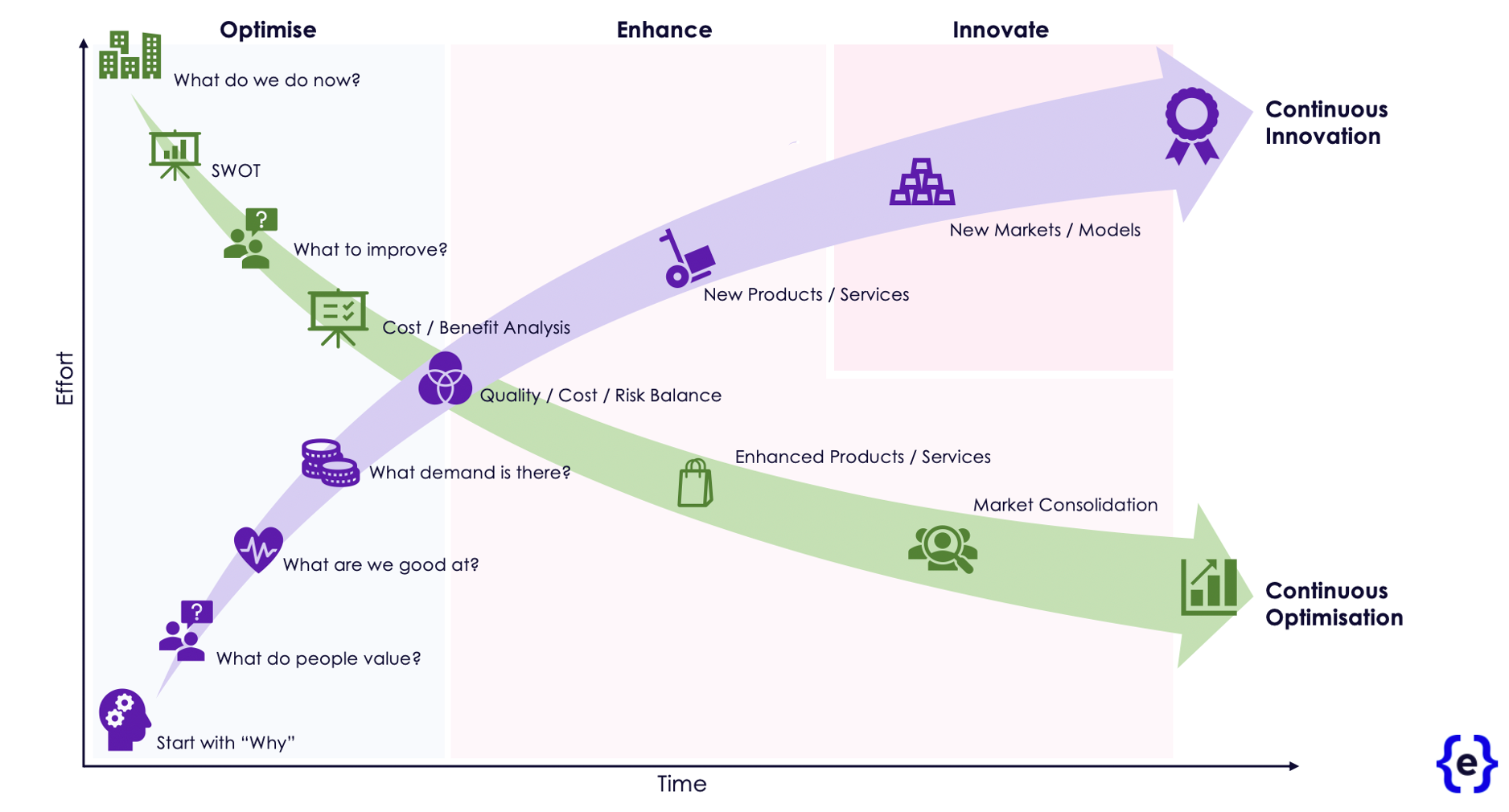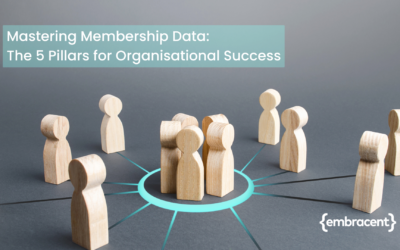In our last article we discussed how the current climate will force many businesses to become much more Efficient, Resilient and Agile in the future. With a new ERA of business already emerging, we must quickly learn to embrace a new future; a new normal.
In this article we discuss the first of those topics – Efficiency – in a little more detail and outline some of the realistic steps that we can take in our businesses to become more efficient.
The Efficiency Conundrum
Driving efficiency is something that many organisations, of all types and sizes, have done for some time – predominantly in order to cut costs in an increasingly competitive world. There are many well-known techniques such as Lean and Six Sigma that are used to improve efficiency and reduce waste. They often result in a range of actions, including:
Standardising
and centralising processes in shared service centres – often driving 20% – 30% cost reduction in support costs.
Outsourcing
non-core activities to third parties in low cost locations – with 15% – 20% cost reduction available for core processes.
Driving Employees
through monitoring performance metrics closely – delivering efficiency gains through aggressive headcount management.
Sweating Assets
to ensure that returns on investment are maximised – pushing long lifecycles for core infrastructure such as computer systems.
Leveraging Scale
to buy products and services at significant discounts – utilising global supply chains to reduce cost.
Purchasing
products and services only when needed (just -in-time) – and aggressively managing working capital.
However, in the current climate, we are seeing first-hand that these types of techniques can lead to significant challenges:
Fixed Business Models:
Fixed global business models, designed for efficiency, can be highly affected by global issues such as the current pandemic
Inflexible Supply Chains:
Just-in-time purchasing can break down quickly if there are challenges in the supply chain e.g. availability of source materials, delays in shipping
Restrictive Contracts:
It can be slow and expensive to change the remit of third-party outsource organisations who may have signed long-term contracts to deliver specific services
Old Systems:
Key systems that have been underinvested for many years may not be flexible and agile enough to cope with significant changes to processes and business models
The problem is that chasing after efficiency alone has led to many businesses becoming much less flexible and agile than they need to be right now.
Short-term cost-saving and shareholder return have been prioritised over longer-term business resilience and strength
So how do we become efficient, without compromising on resilience and agility?
Key to this is the proactive management of the different aspects of Cost, Quality and Risk together as part of a combined approach.
Cost:
How do we operate in a cost conscience way – to ensure that our cost profile is appropriate, rather than lowest cost? Not necessarily lowest cost, but appropriate cost.
Quality:
How do we deliver the level of quality of products, services, operational processes and employee experiences that people value? Not necessarily highest quality, but valued quality.
Risk:
How do we manage the many business and personal risks to a level that we are prepared to accept? Not necessarily lowest risk, but managed risk.
So, where do we start?
Our Continuous Digital Transformation (CDT) Approach
By focusing on a combination of continuous optimisation and continuous innovation, we are able to enhance an organisation in a structured and managed way.
Our CDT approach does exactly this, by helping businesses to fully assess what they are good at, and what customers value. By considering these fundamental questions, and balancing quality, cost and risk, we can create a balanced view of future product and service delivery.
As you will see from the diagram below, our approach takes a structured view of the business, so that effort can be focused on the areas that matter.
There are a number of key parts to this approach:
“Start with Why” (as Simon Sinek would say):
It’s always important to understand why we are in business, and how we are differentiated from our competition. When there are significant changes in market dynamics, it is vital to re-visit this to make sure that previous reasons are still valid today.
Action: Update the Why Statement
Agree what we value (and what we don’t):
Having a very clear picture of what we, our employees and our client’s value is critical to a) optimise existing services and b) innovate for the future. This way we can invest in value-adding products and services and manage cost and efficiency in low-value areas.
Action: Create a Value Map
Understand what we are good at (and check if anyone cares):
With a clear ‘Why Statement’, and a good understanding of our business’s Value Map, we can now agree the skills and capabilities we need for the future. These may well be different from those that we currently possess. Investing in required skills will be critical and ensuring that our corporate culture supports your ambitions.
Action: Create a Capability Model
Balance Risks:
With the significant changes brought about by the recent pandemic, the risk profiles within our business and across our market sectors will have inevitably changed. Some new risks will be purely temporary, and some will be around for some time to come. It is therefore critical to re-visit risk profiles and update risk management processes.
Action: Update Risk Management Processes
In the context of these, we can then:
Optimise:
Minimise any non-value adding activities whilst making all other activity as efficient and effective as possible. For example:
- Using Robotic Process Automation (RPA) to automate finance operations, such as Accounts Payable, Accounts Receivable, Invoice Matching, Month-end closing actions
- Standardising complex ERP systems and removing unnecessary bespoke solutions
- Reducing cost of non-value-adding services, such as network connectivity
- Reducing levels of third-party service delivery that don’t align to value-adding products and services
Enhance:
Improve current products, services and processes to provide greater linkage to value and mitigate core risks. For example:
- Creating RPA centres of excellence to constantly improve operational performance and reduce cost
- Using critical data to provide insight for customers and colleagues and optimise product and service delivery
- Delivering frictionless services to customers using digital channels, thus reducing costs and optimising services
- Automating and integrating suppliers and partners into digital supply-chains to better manage future supply expectations and remove unnecessary planning work
Innovate:
Identify new products, services, processes, ways of working that deliver greater value to customers and employees. For example:
- Changing business models to allow for multiple sourcing options to deliver new routes to market and alternative services at enhanced efficiency levels
- Creating data insights that can be monetised to provide additional revenue streams and identify opportunities to improve efficiency
- Developing new operating models that are digitally native and re-invent how we currently goes to market
- Breaking down the barriers between customer and supplier by providing new services that are fundamentally more efficient to deliver
It is also worth noting that this is not a one-off process. As businesses and markets continue to change, and significant new risks become apparent, it is critical to continually re-visit this approach.
In Summary:
Efficiency can be balanced with Resilience and Agility, by continuously reviewing the following areas:
Value:
Continually assessing what our customers, partners and employees value
Risks:
Understanding the risks and rewards with the associated business models
Culture & Capabilities:
Making sure we have the capabilities and culture to succeed
Business Models:
Constantly revisiting operating models and processes on a regular basis to ensure that they are well aligned to value
Optimisation:
Driving efficiency in non-value adding areas to manage cost and reduce complexity
Innovation:
Innovating in value-adding areas to deliver new and better services that meet the needs of the market

Mark Lockton Goddard
Other Interesting Reads
AI for Onboarding: A glimpse at the not-so-distant future for HR Directors
Artificial Intelligence (AI) has experienced a breakthrough year in 2023. But how we embrace AI and Machine Learning (ML) without losing sight of the bigger picture – and how we can be “better together” – is a conversation that we should all be having.
With that in mind, we invite you to see how AI has impacted Santa Clause this year in our short Christmas video.
embracent Christmas Video 2023
Artificial Intelligence (AI) has experienced a breakthrough year in 2023. But how we embrace AI and Machine Learning (ML) without losing sight of the bigger picture – and how we can be “better together” – is a conversation that we should all be having.
With that in mind, we invite you to see how AI has impacted Santa Clause this year in our short Christmas video.
Mastering Membership Data: The Five Pillars for Organisational Success
Explore how understanding members, aligning services, monitoring member activity, optimising internal operations, and tapping into external insights can revolutionise your organisation’s performance.




